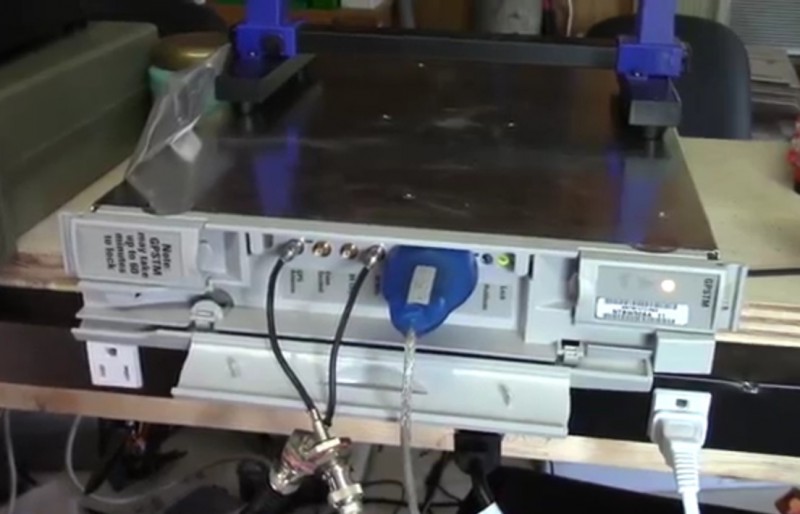[Shane Burrell] came across a Nortel GPSTM and re-purposed it as a 10MHz reference for his lab. The GPSTM is designed to slot into a backplane, most likely for telecoms applications. So [Shane] needed to hack the board to run from a 48v PSU. Once powered up, it was relatively easy to interface as the card appears to contain the well known Trimble Thunderbolt module and is compatible with its software.
We’ve covered frequency references before and they can be a valuable addition to a lab. On the back of most scopes, spectrum analyzers and function generators you’ll find a 10MHz reference input allowing the user to supply a reference more accurate than that generated internally. Not only is an external reference often more accurate, it also allows you to keep all your equipment in sync with a common reference, which can be particularly important in some measurements. While some hackers opt for Rubidium sources, the GPS disciplined temperature-controlled oscillator in the Nortel unit should provide a nice stable reference.
A word of warning to [Shane] though, get sucked into hacking frequency references and you may become a time nut finding yourself climbing mountains to test the theory of relativity.
















You don’t need to climb a mountain, NIST just did it with two references and measured the speed-up with a difference of 1 foot (33cm) on a lab-table jack. [Forbes article by Chad Orzel]
And their experiment was a repetition of one originally performed by the Greeks. If only Alexandria had survived…
Except such an experiment used two custom build atomic clocks (the NIST experiment used one based on aluminum ions).
I don’t know of anyone outside a national physics lab or a commercial company (like Symmetricom) that has built an actual atomic clock (oscillator). The last I checked on time-nuts mailing list, it was considered possibly given plenty of resources, but not economical sensible to try to build your own. A small number of time-nuts do have surplus commercially manufactured Cesium references, and a couple have hydrogen masers.
The Rubidium clocks are atomic clocks. Just not quite as accurate as the Caesium or Hydrogen ones.
I wonder how many fractions of a second they are off.? I’m thinking about .00000009.
The question with relitively is, if we are rotating and orbiting, which is itself orbiting the galaxy, does the rate of spin change as we alter our relitive distances from these orbital centre points or is it time that is distorted.
If all time is distorted along a path and it effects everything within it, how would anyone ever know.
42!
I may be incorrect, but I believe that Einstein’s theory of relativity demonstrates that the perception and measurement of time is dependent upon the frame of reference where it is being measured. If this is correct (and I’m completely open to the possibility that I have this completely wrong), it is possible that everyone in the universe experiences time differently, if only minutely.
There is experimental data that becks up Einstein’s theory. I think that similar experiments could possibly answer your question.
Again, I could be completely wrong about all of this, so please take what I say with a grain of salt.
You’re not wrong, and kudos to you for being patient enough to reply. I was preparing some unwarranted snark.
It isn’t precisely a Thunderbolt; part of the silicon is fixed to output a 0.5Hz (PP2S) pulse, which is useful in the CDMA world but really hard to make NTP understand. On a real Thunderbolt that would be configurable.
Luckily the 1Hz (1PPS) signal is available inside the unit, as has been discovered by a few time-nuts experimenters, detailed here:
https://www.i3detroit.org/wiki/Nortel_GPSTM
I don’t use the .5hz output but I know there is a NTP patch for using it direct. The TP for the 1pps I didn’t know about and if I ever take it back down defiantly something I’d bring to the outside. It doesn’t appear to come out on the rear connector at all.
Actual mountian data here: http://leapsecond.com/great2005/
Thanks for the link, I’d not seen the original source before and it makes great reading.
I have one of these units, they’re great.
I use a $20 ublox GPS module with 10MHz and 1PPS output. ns size jitter might make useless for relativity experiments but for a bench reference it works just fine.
What is the part number of that ublox module?
The PCI-5S module is $8 and has a timepulse output exposed as a testpoint. (Previously covered on hackaday.)
http://www.ebay.com/sch/i.html?_nkw=pci-5s+gps&_sacat=0
http://emerythacks.blogspot.com/2013/01/u-blox-pci-5s-cheap-gps-module-for-your.html
That’s perfectly suitable as an NTP reference, as long as you configure the U-Blox to stop outputting timepulse if it loses satellite lock. (Make sure “allow async” is unchecked.)
You could also use any of these units to DIY a disciplined quartz oscillator; there’s nothing magical about the concept, and it’s actually a really cool project. You need a temperature-controlled chamber for the oscillator (most folks just by a TCXO module), some means of comparing the 10MHz coming out of the oscillator with the 1Hz coming from the GPS, and some means of adjusting the oscillator to bring it in line. The simplest one I’ve seen uses a microcontroller clocked straight off the 10MHz, and then makes sure it counts ten million ticks between 1Hz pulses. If more or less, it tweaks the oscillator tuning in very fine increments.
The ublox NEO-M8N but other models work. the 6M will only give up to 100kHz output
http://vk4zxi.blogspot.com/2014/09/cheap-gps-disciplined-10-mhz-oscillator.html